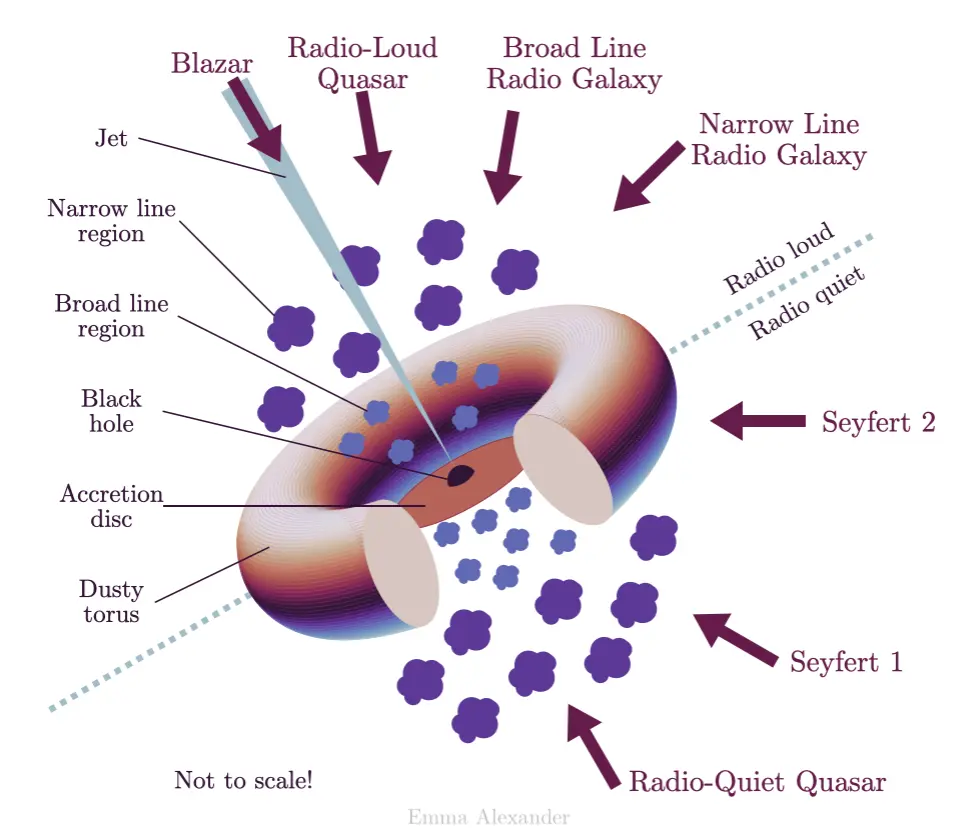From a single gas to many galaxies
The growth of galaxies from the dense patches of the primordial gas has been simulated using supercomputers at the Max Planck (the eponym of Planck time and Planck satellite) Institute for Astrophysics in Garching, near Munich, Germany. A part of the simulation is shown in the video. Here Mpc stands for megaparsec and 50 Mpc is equal to almost 160 million light years (ly). So you see the evolution of a 500 million-light-year patch of the universe in time. The letter z stands for “redshift” which is a proxy for time here. The animation begins at z=20, when the universe was only 200 million years old, and ends at z=0 which is the present time.
But what you see here is actually the evolution of dark matter, not the visible matter (gas), because 85% of all matter in the universe is dark, invisible, undetectable with our current technology. Perhaps, dark matter started producing the scaffolding or the foundational structure within which visible gas later fell and turned into galaxies. The initial single gas later developed into the “cosmic web” of galaxies and voids by the end of the galactic age.
Cosmic Web of Dark Matter
According to our current understanding of Einsteinian STEM, 68% of all EM (energymatter) in the universe is dark energy, undetectable using our current technology, 27% is made of dark matter, and only 5% constitute all the visible or detectable matter from gorillas to galaxies, everything that is made of electrons, protons and neutrons. As mentioned above, the dark matter created the foundational structure within which galaxies later formed. So dark matter is subjected to gravity, but dark energy is against gravity. Gravity tries to pull the universe back together, dark energy tries to push it farther apart.
The cosmic web, a result of the struggle between dark matter and dark energy, looks similar to the neural network of a human brain. Both are like a spider’s web. The cosmic web is made of nodes and filaments of galaxies. A node is a gigantic galaxy cluster or supercluster made of thousands of galaxies. A filament connecting different nodes is made of a smaller number of galaxies and galaxy groups. The empty places between the filaments and nodes are called voids, made of the least dense gas in the universe. In a neural network, the nodes and filaments are made of neurons, or nerve cells. Why are they so similar? And what is their connection with Artificial Neural Networks (ANN) that we use to build AI (artificial intelligence) systems?
The Milky Way
The Milky Way, our galactic home, is a collection of stars, gas, and dust, stretching roughly 100,000 light-years across. Imagine a grand spiral, with our Solar System tucked away within one of its arms like a speck on a ballerina’s skirt. This intricate structure, estimated to hold more than 100 billion stars, is where countless suns shine, planets whisper in their orbits, and nebulae glow like cosmic paint splatters.
At the heart lies a majestic central bar, teeming with ancient stars, radiating outwards into graceful spiral arms. These arms, laced with cool gas and dust, become cradles for new star births, their brilliance briefly igniting before fading into slumbering giants or spectacular supernovas. Beyond the grand design, a halo of faint stars extends, remnants of captured galaxies, whispering tales of the Milky Way’s turbulent past.
With a journey around the galactic center taking a staggering 250 million years, our understanding of this vast system remains a work in progress, fueled by ongoing exploration and the constant twinkle of starlight painting the night sky. So next time you gaze upwards, remember, that faint band of light is not just a beautiful sight, it’s the very essence of our galactic home, waiting to be unraveled.
Other galaxies and Expanding universe
Until the year 1924 we did not know for sure that there other galaxies in the universe except our own. Astronomers knew about fuzzy objects like the Andromeda you see in the attached photograph. But they thought these are gaseous objects inside our galaxy. German philosopher Immanuel Kant thought them to be separate “island” universes, but no one took him seriously until Edwin Hubble, an American astronomer, proved in 1924 that Andromeda is not a nebula inside the Milky Way, but a galaxy on its own right. Hubble measured the distance of Andromeda and other galaxies at the Mount Wilson Observatory using a method first developed by Henrietta Swan Leavitt.
And these measurements of distance gave rise to one of the most iconic scientific discoveries of the 20th century: the expansion of the universe. Einstein, like Newton and Aristotle, thought the universe was static. But Hubble first found that all distant galaxies are receding from us. And, even more surprisingly, the farther a galaxy is from us the faster it is receding away from us. His plot of velocity vs. distance is shown in the attached figure. Only one fact could explain this puzzling phenomenon. All the galaxies must have started from a single point through an explosion. But why? How does this prove the fact of explosion, the big bang?
Types of Galaxies
Hubble was also the first one to come up with a classification scheme for galaxies. The scheme is now called the Hubble sequence, which looks like a tuning fork having two tines. At the handle of the fork we place the elliptical galaxies and at the two tines two types of spiral galaxies: the regular ones and the barred ones. The neck of the fork holds galaxies that are a mix of ellipticals and spirals: the lenticular galaxies. Ellipticals are oval like eggs and the spirals are flat like disks. The regular spirals have spiral arms coming out of a central bulge on the disk. The barred spirals have spiral arms coming out of the ends of a central bar on the disk. The lenticulars have a disk and bulge, but no spiral arms.
The Hubble sequence was not always what it is today, it evolved. About 11 billion years ago, more than half of the galaxies were irregular with no well-defined shape, the spirals and ellipticals were only beginning to form. Only 30% of the galaxies were spiral, 15% elliptical and 5% elliptical then. But now almost 70% of all galaxies are spiral and only 10% irregular. The attached diagram show an intermediate stage around 4 billion years ago when the spirals were more well-shaped. The irregular galaxies are not shown in the diagram.
Active Galaxies and Supermassive Black Holes
The very largest galaxies have supermassive black holes (SMBH), millions of times more massive than the sun, surrounded by fiery accretion disks. They are called active galaxy or Active Galactic Nucleus (AGN) because the nucleus (center) of the galaxy surpasses the whole galaxy in brightness. Extremely energetic jets coming out of the two poles of the central SMBH are powered by the gas, dust and stars in the accretion disk.
AGNs of course vary, but the variation we see are only apparent because it depends on the angle at which we are looking at them. There is a unified model of AGNs that describes them as a donut filled with a thin disk and a hole. The hole at the center is the black hole, the disk is the accretion disk that feeds the black hole, and the torus is a dusty obstruction surrounding the whole center. Jets are ejected from both poles of the black hole, but we see only one of them at best, because if one of them is pointed toward us the other one must be pointed away from us. Sometimes our line-of-sight does not intersect the jet, but other parts of the disk or surrounding regions. Think of a lighthouse that is releasing a beam of light in only one direction and we see the lighthouse very differently from different directions.
In the attached figure, the top side is the loud side (jet toward us) and the bottom the quiet side (jet not aligned toward us). The galaxies that we see head-on from the loud side are blazars, and if we look head-on from the quiet side we find radio-quiet quasars (faint in radio light). If we can see the jet only at a small angle, it is a radio-loud quasar. If our line-of-sight has a bigger angle with the jet, we will see either a broad-line or a narrow-line radio galaxy. If we look at an angle on the quiet side, we will find a Seyfert 1 galaxy. And if only the accretion disk is toward us, we call it a Seyfert 2 galaxy.
Because of the dusty torus an AGN cannot be seen in visible light. Only infrared and radio light are helpful here. The jet emits light mostly at radio wavelengths. And the dusty torus reemits the light it receives from the center at infrared wavelengths.
Galaxy Clusters
Galaxy clusters are made of 85% dark matter, 15% gas in the intracluster medium (ICM) and a few thousand galaxies that make up only 5% of the total mass. The gas are located between the galaxies. A cluster can be classified depending on the distribution of its galaxies as shown in the second of the attached figures. The cD clusters are those which are dominated by a central huge elliptical galaxy, and the Bs contain a pair of bright galaxies in the center. Ls are clusters with a nearly linear alignment of the dominant galaxies, Cs have a single core of galaxies, Fs are clusters with an oblate galaxy distribution, and Is are clusters with an irregular distribution. A galaxy cluster can be as big as ten million light years (Mly).
Unlike the galaxies, the ICM cannot be seen in visible light. But the gas in the ICM emits x-rays which we can capture using space telescopes like Chandra. In the attached image, the gas in the Bullet cluster is shown using red color. The dark matter is undetectable by definition, but its presence can be mapped indirectly using the bending of the light coming from galaxies more distant than the cluster. The dark matter distribution is shown in blue in the image. The bullet cluster is actually a merger between two clusters. As they merged, their dark matter halos easily passed each other and they are now located far from each other as evident from the positions of the two blue patches. But their ICM gas could not easily cross each other because of mutual collisions. You can clearly see that the red patches are closer to each other and the ICM of one cluster has even taken the shape of a bullet because of the collisions. The galaxies (seen in visible light) mostly follow the dark matter distribution, the blue patches.











